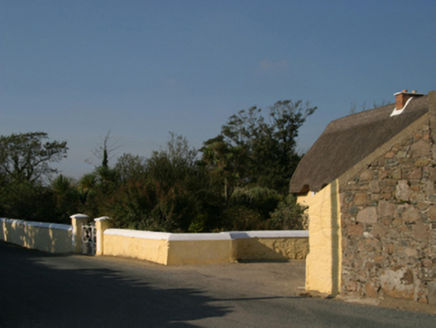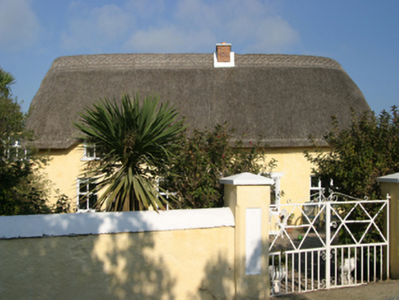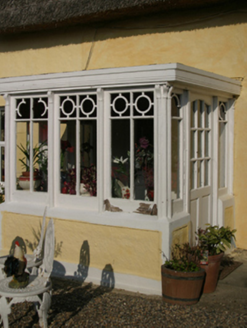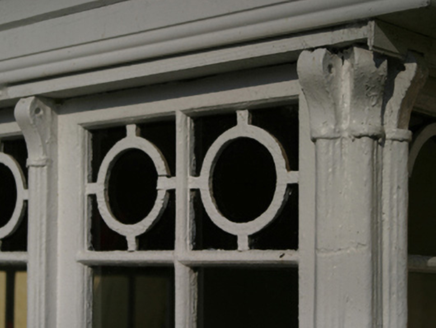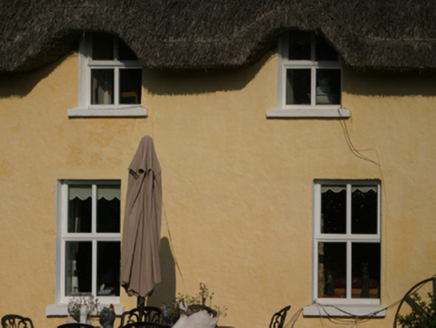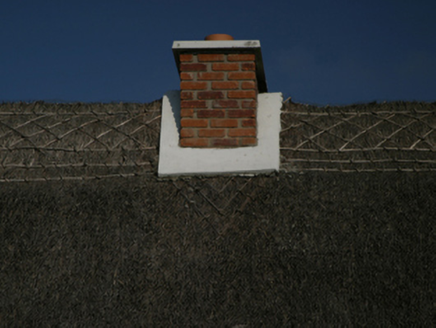Survey Data
Reg No
15705316
Rating
Regional
Categories of Special Interest
Architectural, Artistic, Historical, Social
Original Use
Farm house
In Use As
Farm house
Date
1700 - 1840
Coordinates
311978, 106294
Date Recorded
24/10/2007
Date Updated
--/--/--
Description
Detached four-bay single-storey lobby entry thatched farmhouse with half-dormer attic, extant 1840, on an L-shaped plan off-centred on single-bay single-storey flat-roofed projecting glazed porch; single-bay (single-bay deep) full-height return (north). "Improved", pre-1903, producing present composition. Occupied, 1911. Renovated, 2005-6. Chicken wire-covered replacement hipped oat thatch roof with exposed hazel lattice stretchers to ridge having exposed scallops, red brick Running bond off-central dwarf chimney stack having concrete capping supporting terracotta pots, and exposed hazel stretchers to eaves having exposed scallops; pitched slate roof (north) with clay ridge tiles, concrete or rendered coping to gable with red brick Running bond chimney stack to apex having corbelled stepped capping supporting terracotta or yellow terracotta octagonal pots, and cast-iron rainwater goods on rendered slate flagged eaves retaining cast-iron downpipes. Stained lime rendered battered walls; rendered surface finish (north). Square-headed off-central door opening into farmhouse. Square-headed window openings with concrete or rendered sills, and concealed dressings framing replacement uPVC casement windows replacing two-over-two timber sash windows having part exposed sash boxes. Set back from line of road in landscaped grounds with rendered chamfered piers to perimeter having shallow pyramidal capping supporting wrought iron-detailed flat iron double gates.
Appraisal
A farmhouse identified as an integral component of the vernacular heritage of south County Wexford by such attributes as the compact rectilinear lobby entry plan form off-centred on an expressed, albeit later porch; the construction in unrefined local materials displaying a battered silhouette; the disproportionate bias of solid to void in the massing; and the high pitched roof showing an oat thatch finish replenished with the financial assistance of a grants (2005; 2008) from The Heritage Council and Wexford County Council: meanwhile, aspects of the composition clearly illustrate the continued development or "improvement" of the farmhouse in the later nineteenth century. Having been well maintained, the elementary form and massing survive intact together with substantial quantities of the original fabric, both to the exterior and to the interior: the recent (2005-6) introduction of replacement fittings to most of the openings, however, has not had a beneficial impact on the character or integrity of a farmhouse cited as the birthplace of Reverend Thomas Furlong (1800-75), Bishop of Ferns (fl. 1857-75); Reverend John Lambert Furlong (1836-1907); and Reverend Patrick Furlong (1844-1914).
